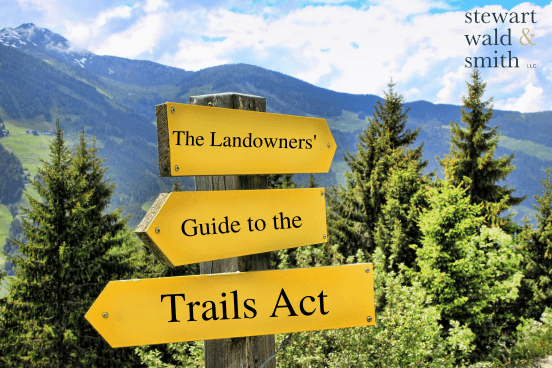
Rail-to-trail conversions are only possible thanks to the Trails Act, an act of Congress that allows railroads to offer up their railroad rights-of-way for public recreational hiking and biking use in lieu of abandonment. But what is the National Trails System Act, otherwise known as the Trails Act, and why does it lead to just compensation for landowners?
This guide intends to provide those answers.
Intercontinental Railroad Expansion
Railroads played a large role in the development of the United States during the Industrial Revolution. The Baltimore and Ohio Railroad kicked things off with the first passenger and freight line in the nation in 1827, and, due to westward expansion, railroads continued to flourish, with major railway projects popping up across the country for the next 45 years. By 1860, the North and Midwest featured railway networks that linked every major city. By the Great Depression, more than 80 percent of farms were within five miles of a railway.
Railroads used different methods to acquire land necessary to expand the railway system in the 1800’s and 1900’s, including:
- Land grants from the United States government, which typically granted the railroad company an easement.
- Condemnation, a process through which the railroad company could take land through a lawsuit and payment of just compensation to the landowner. Typically, condemnations granted only easements for railroad purposes.
- Deeds granting the railroad right-of-way as an easement.
- Deeds granting a fee simple interest in the land.
“Fee simple” and “easement” are legal terms that describe the type of interest the railroad acquired in the land. Where the railroad acquired the “fee simple,” it acquired the entire, unrestricted ownership of the land. However, where the railroad acquired an “easement,” it acquired only the right to use the land for railroad purposes.
After the Great Depression, many railroads found themselves bankrupt, which effectively ended the railway system boom in America. Soon after, trucks began to replace freight traffic, and automobiles and airplanes drastically decreased the need for passenger trains. To illustrate through numbers, railway system route mileage peaked in 1916 at 254,251 miles, and by 2014, it fell to 94,372 miles (www.railserve.com).
The Trails Act
During the boom, rail companies went to great lengths to construct the impressive network of railroad rights-of-way across the country. However, as railroad customers (both freight and passenger) turned to other means of transportation, the railroads were often left with a no-win situation: either keep maintaining long stretches of land with no practical or profitable use, or completely abandon their rights-of-way. To provide relief from this choice and preserve the country’s massive investment in infrastructure that it took to build the railroad network, Congress enacted the Trails Act.
Enacted in 1963 and amended in 1983, the Trails Act is a federal statute that empowers the Surface Transportation Board (“STB”) to authorize conversion of railroad rights-of-way to recreational trails, which preserves the line for future reactivation of the railroad. This concept is known as “railbanking.” Although railbanking is intended to “preserve” the line for potential railroad use, effectively, it permanently converts the railroad right-of-way to a linear public hiking and biking park.
Typically, the process of converting a railroad right-of-way to a recreational hiking and biking trail goes through the following steps:
- The railroad files a petition to abandon certain portions of its rail line with the STB, the federal government entity that regulates railroads.
- The STB authorizes the railroad to negotiate with potential trail users (the entities, usually public, who will operate and maintain the trail) to transfer the line, and, if there is no potential trail user, to abandon the line.
- If a potential trail user steps in to negotiate, it notifies the STB, and the STB issues a Notice of Interim Trail Use (“NITU”) that authorizes the conversion of the railroad right-of-way to a recreational trail through railbanking. However, railbanking only becomes permanent if the railroad and the trail user reach an agreement for the trail user to take over operation and maintenance of the corridor.
- If the railroad’s negotiations with a potential trail user are successful, the railroad notifies the STB that it reached a trail use agreement with the trail user. At that point, the line is indefinitely railbanked for trail use.
Taking Claims Based On the Trails Act
Congress enacted the Trails Act to preserve important infrastructure and to provide the public with thousands of miles of linear park land, but as a side effect, the Act deprived landowners along the converted corridors of property rights. Ordinarily, if a railroad abandons its right-of-way, then land where it only holds an easement (the right to use the land for railroad purposes only) reverts to adjacent landowners’ possession according to state law. However, the Trails Act steps in and prevents that process from happening. Instead, the STB transfers operation and maintenance of the right-of-way to the trail user and imposes a new easement for recreational trail use, which blocks the land from returning to adjacent landowners.
That blocking of state property rights results in a “taking” of property under the Fifth Amendment, as the federal government (through the Trails Act) effectively takes landowners’ property by preventing the property from returning to its rightful owner. The Trails Act is constitutional (meaning the government has the right to convert the corridors to trails), but only if the government pays just compensation to landowners for the value of the land that the STB authorizes for trail use. This is because the Fifth Amendment allows the government to take land for public use, but only if the government also pays fair and reasonable compensation for that use.
Theoretically, this constitutional process creates a win-win-win scenario under the Trails Act: the railroad gets to move off a costly, unprofitable asset; the public gets a nice, linear park; and the adjacent landowners get paid. While many landowners may wish for their land back over any monetary award, the Constitution only allows one option for relief: just compensation through a takings claim.
Pursuing a Trails Act Claim
Because of the unique nature of railroad easements, where the railroad acquired the land more than a century ago and seems to own the land outright, landowners are often unaware of their property rights in the railroad’s right-of-way. However, they are presumed to own the land in the corridor thanks to the centerline presumption, and the government owes them just compensation for preventing their rights from materializing.
To recover just compensation, landowners must file a takings claim against the federal government through an action for inverse condemnation based on the Trails Act. Unlike in direct condemnations, where the government identifies and sues property owners to take their land and then compensate them accordingly, eligible landowners in an inverse condemnation action must affirmatively bring a claim for just compensation against the government.
A rails-to-trails inverse condemnation case is usually filed in the United States Court of Federal Claims in Washington, D.C (the “CFC”). This is because the CFC has jurisdiction to hear all claims for compensation against the federal government. Because of the unique nature of Trails Act cases, there are very few firms in the nation that represent landowners for takings claims based on the Trails Act. Stewart, Wald & Smith is the only one that specializes in rails-to-trails cases exclusively and is proud to share the accomplishment of having recovered the most money for landowners in the history of rails-to-trails cases. If you own land along an abandoned or soon-to-be abandoned railroad and have heard rumblings in your community about a future rail trail, representatives of Stewart, Wald & Smith are always available to answer any questions and advise you on your rights.

